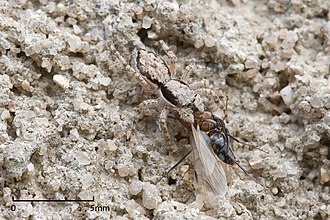Crypsis


Crypsis is a biological phenomenon and survival strategy used by various organisms to avoid detection by predators or prey. It encompasses a range of methods for achieving invisibility or blending into the environment, including camouflage, mimicry, and other forms of visual, olfactory, or auditory deception. Crypsis is a critical aspect of the natural selection process, influencing the evolution of species in diverse ecosystems.
Mechanisms of Crypsis[edit]
Crypsis can be achieved through several mechanisms, each tailored to the specific environment and threats faced by the organism. These mechanisms include:
Camouflage[edit]
Camouflage is the most well-known form of crypsis, allowing organisms to blend in with their surroundings to avoid detection. This can be achieved through coloration, patterns, and textures that mirror the environment. Examples include the chameleon's ability to change its skin color and the leaf-tailed gecko, which mimics the appearance of leaves.
Mimicry[edit]
Mimicry involves one organism resembling another organism or object, often one that is poisonous, dangerous, or unpalatable to predators. This resemblance can deter potential threats. The monarch butterfly, which is toxic, is often mimicked by the non-toxic viceroy butterfly to avoid predation.
Motion Dazzle[edit]
Motion dazzle involves the use of high-contrast patterns to confuse predators during movement. This can make it difficult for a predator to accurately judge the speed and direction of the prey. An example is the zebra's stripes, which may help to confuse predators during a chase.
Counter-Shading[edit]
Counter-shading is a form of camouflage where an organism's coloration is darker on the upper side and lighter on the underside. This helps to counteract the effect of sunlight, making the organism less visible from both above and below. Many marine animals, such as sharks, exhibit counter-shading.
Behavioral Crypsis[edit]
Behavioral adaptations can also contribute to crypsis. This includes remaining motionless, hiding, or using materials from the environment to cover oneself. The octopus, for example, can alter its texture and color to match its surroundings and can also hide by creating a cloud of ink.
Evolutionary Significance[edit]
Crypsis plays a significant role in the evolutionary arms race between predators and prey. The effectiveness of an organism's crypsis strategies can directly impact its survival and reproductive success, driving the evolution of more sophisticated forms of crypsis and detection.
Applications in Human Technology[edit]
The principles of crypsis have inspired various applications in human technology, particularly in military camouflage. By understanding and applying the mechanisms of crypsis, humans have developed clothing, vehicles, and structures that are harder to detect by enemies.
See Also[edit]

Ad. Transform your life with W8MD's Budget GLP-1 injections from $75


W8MD offers a medical weight loss program to lose weight in Philadelphia. Our physician-supervised medical weight loss provides:
- Weight loss injections in NYC (generic and brand names):
- Zepbound / Mounjaro, Wegovy / Ozempic, Saxenda
- Most insurances accepted or discounted self-pay rates. We will obtain insurance prior authorizations if needed.
- Generic GLP1 weight loss injections from $75 for the starting dose.
- Also offer prescription weight loss medications including Phentermine, Qsymia, Diethylpropion, Contrave etc.
NYC weight loss doctor appointmentsNYC weight loss doctor appointments
Start your NYC weight loss journey today at our NYC medical weight loss and Philadelphia medical weight loss clinics.
- Call 718-946-5500 to lose weight in NYC or for medical weight loss in Philadelphia 215-676-2334.
- Tags:NYC medical weight loss, Philadelphia lose weight Zepbound NYC, Budget GLP1 weight loss injections, Wegovy Philadelphia, Wegovy NYC, Philadelphia medical weight loss, Brookly weight loss and Wegovy NYC
|
WikiMD's Wellness Encyclopedia |
| Let Food Be Thy Medicine Medicine Thy Food - Hippocrates |
Medical Disclaimer: WikiMD is not a substitute for professional medical advice. The information on WikiMD is provided as an information resource only, may be incorrect, outdated or misleading, and is not to be used or relied on for any diagnostic or treatment purposes. Please consult your health care provider before making any healthcare decisions or for guidance about a specific medical condition. WikiMD expressly disclaims responsibility, and shall have no liability, for any damages, loss, injury, or liability whatsoever suffered as a result of your reliance on the information contained in this site. By visiting this site you agree to the foregoing terms and conditions, which may from time to time be changed or supplemented by WikiMD. If you do not agree to the foregoing terms and conditions, you should not enter or use this site. See full disclaimer.
Credits:Most images are courtesy of Wikimedia commons, and templates, categories Wikipedia, licensed under CC BY SA or similar.
Translate this page: - East Asian
中文,
日本,
한국어,
South Asian
हिन्दी,
தமிழ்,
తెలుగు,
Urdu,
ಕನ್ನಡ,
Southeast Asian
Indonesian,
Vietnamese,
Thai,
မြန်မာဘာသာ,
বাংলা
European
español,
Deutsch,
français,
Greek,
português do Brasil,
polski,
română,
русский,
Nederlands,
norsk,
svenska,
suomi,
Italian
Middle Eastern & African
عربى,
Turkish,
Persian,
Hebrew,
Afrikaans,
isiZulu,
Kiswahili,
Other
Bulgarian,
Hungarian,
Czech,
Swedish,
മലയാളം,
मराठी,
ਪੰਜਾਬੀ,
ગુજરાતી,
Portuguese,
Ukrainian